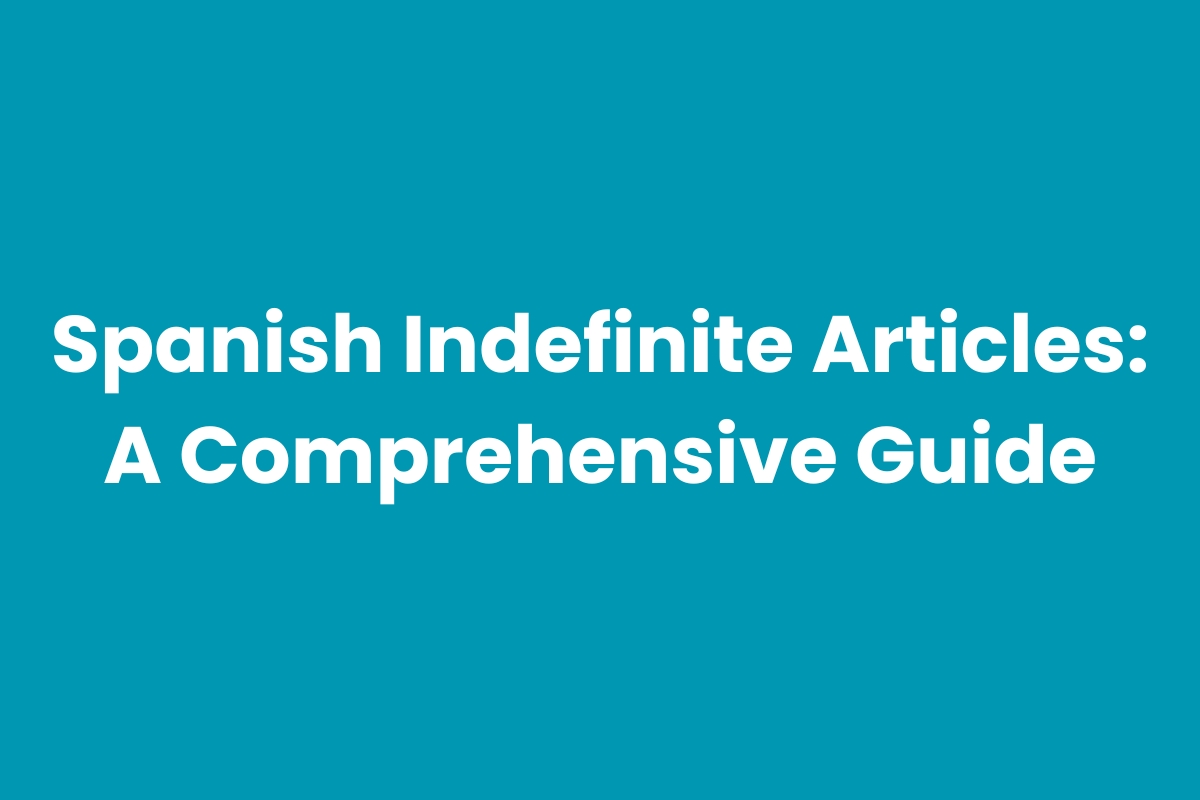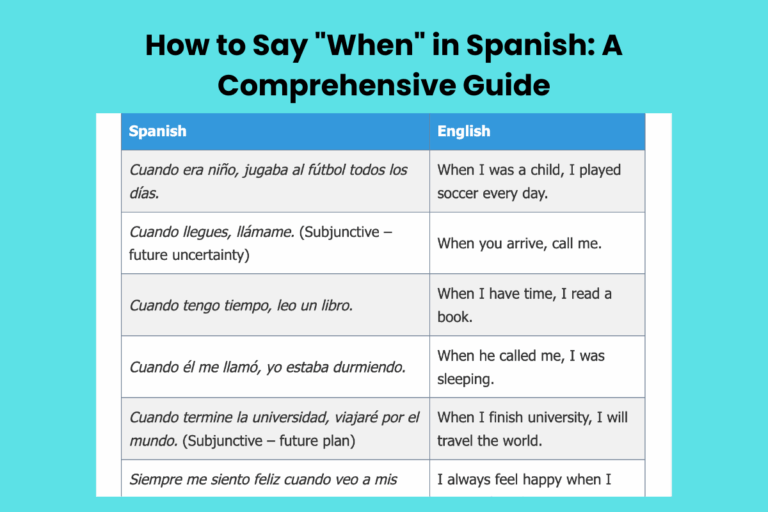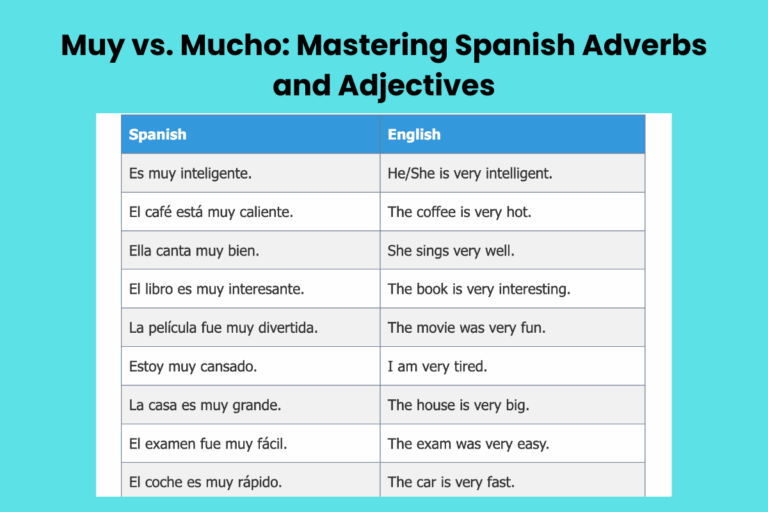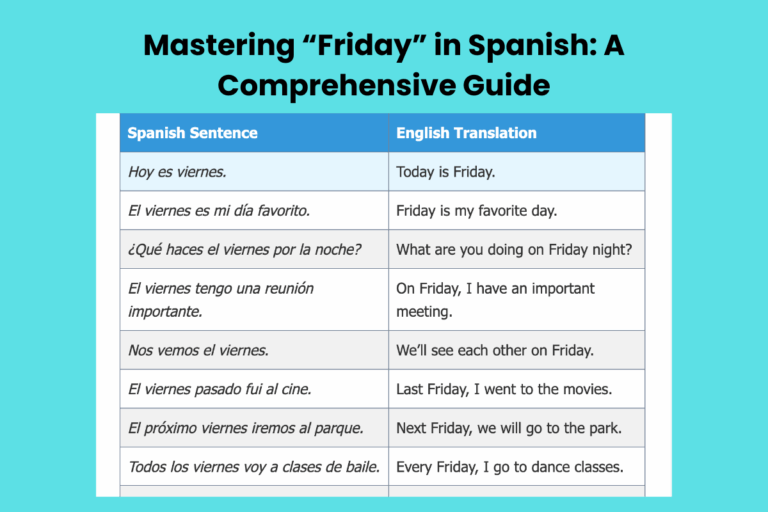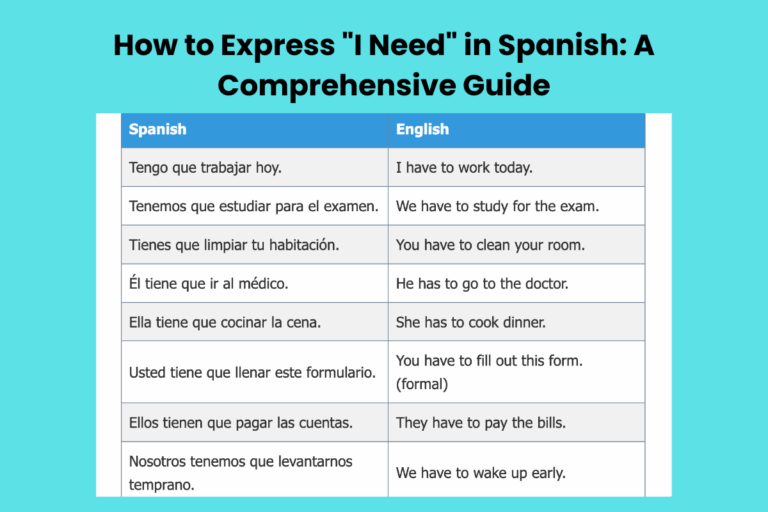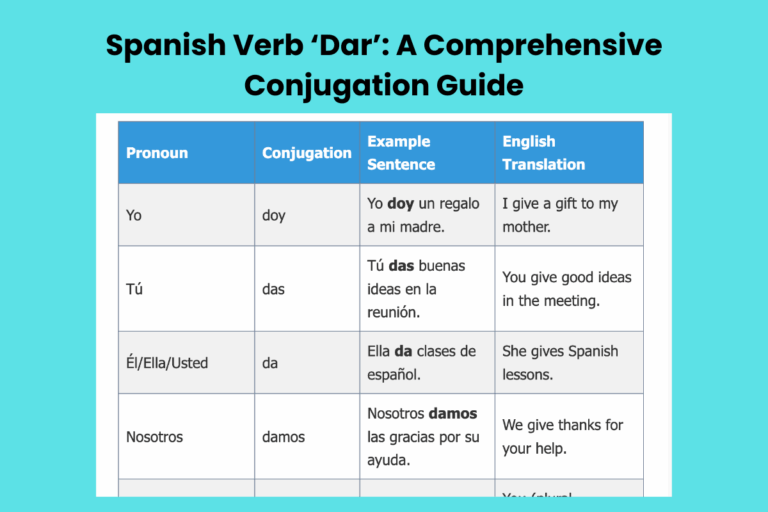Spanish Indefinite Articles: A Comprehensive Guide
Mastering indefinite articles is crucial for fluency in Spanish. These small words—un, una, unos, and unas—indicate nonspecific or undefined nouns. Understanding their proper usage is fundamental to constructing grammatically correct and natural-sounding sentences. This guide provides a detailed exploration of Spanish indefinite articles, covering their forms, functions, and nuanced applications. Whether you’re a beginner or an advanced learner, this article will deepen your understanding and improve your accuracy in using Spanish indefinite articles, ultimately enhancing your overall communication skills.
Table of Contents
- Definition of Indefinite Articles
- Structural Breakdown
- Types and Categories
- Examples
- Usage Rules
- Common Mistakes
- Practice Exercises
- Advanced Topics
- FAQ
- Conclusion
Definition of Indefinite Articles
Indefinite articles in Spanish (artículos indefinidos) are words used to introduce nonspecific or unidentified nouns. Unlike definite articles (el, la, los, las), which refer to specific or known entities, indefinite articles indicate that the noun being referenced is one of many or is being mentioned for the first time. They serve to signal that the speaker is not referring to a particular or previously identified item, person, or concept. Understanding this distinction is essential for clear and accurate communication in Spanish. The indefinite articles are un (masculine singular), una (feminine singular), unos (masculine plural), and unas (feminine plural).
The primary function of indefinite articles is to introduce new information or to refer to a noun in a general, non-specific way. They are crucial for conveying whether you are talking about a specific instance of something or just any instance of it. For example, saying “Quiero un libro” (I want a book) implies you want any book, not a particular one. This contrasts with “Quiero el libro” (I want the book), which indicates a specific book that both speaker and listener are aware of. Indefinite articles are fundamental for building coherent sentences and expressing intended meanings accurately.
Structural Breakdown
Spanish indefinite articles are directly related to the gender and number of the noun they modify. The article must agree in both gender (masculine or feminine) and number (singular or plural) with the noun.
This agreement is a fundamental aspect of Spanish grammar. The structure is straightforward: identify the gender and number of the noun, then select the corresponding indefinite article.
This seemingly simple rule is crucial for constructing grammatically correct sentences.
The structure is as follows:
- Masculine Singular: un + masculine singular noun (e.g., un libro – a book)
- Feminine Singular: una + feminine singular noun (e.g., una casa – a house)
- Masculine Plural: unos + masculine plural noun (e.g., unos libros – some books)
- Feminine Plural: unas + feminine plural noun (e.g., unas casas – some houses)
Understanding this basic structure is the foundation for using indefinite articles correctly. Pay close attention to the gender and number of the noun to ensure proper agreement.
Mistakes in agreement are common, especially for learners, but mastering this concept is essential for fluency. Remember to practice identifying the gender and number of nouns to improve your accuracy.
Types and Categories
Spanish indefinite articles are categorized based on gender and number, as detailed below. Each form has specific applications and must be used in accordance with the noun it modifies.
Mastering these categories is essential for grammatical accuracy.
Masculine Singular (un)
The masculine singular indefinite article un is used before masculine nouns in the singular form. It indicates one unspecified item of a masculine gender. For example, “un perro” means “a dog,” where “dog” is a masculine noun and the speaker is referring to any dog, not a specific one. This form is fundamental for introducing masculine singular nouns in a general sense.
Examples:
- Un chico (a boy)
- Un coche (a car)
- Un problema (a problem)
Feminine Singular (una)
The feminine singular indefinite article una is used before feminine nouns in the singular form. It indicates one unspecified item of a feminine gender. For example, “una mesa” means “a table,” where “table” is a feminine noun and the speaker is referring to any table, not a specific one. This form is equally important for introducing feminine singular nouns in a general sense.
Examples:
- Una chica (a girl)
- Una casa (a house)
- Una pregunta (a question)
Masculine Plural (unos)
The masculine plural indefinite article unos is used before masculine nouns in the plural form. It indicates some unspecified items of a masculine gender. For example, “unos perros” means “some dogs,” where “dogs” are masculine nouns and the speaker is referring to an unspecified number of dogs. Unos can also sometimes imply “approximately”.
Examples:
- Unos chicos (some boys)
- Unos coches (some cars)
- Unos problemas (some problems)
Feminine Plural (unas)
The feminine plural indefinite article unas is used before feminine nouns in the plural form. It indicates some unspecified items of a feminine gender. For example, “unas mesas” means “some tables,” where “tables” are feminine nouns and the speaker is referring to an unspecified number of tables. Unas can also sometimes imply “approximately”.
Examples:
- Unas chicas (some girls)
- Unas casas (some houses)
- Unas preguntas (some questions)
Examples
This section provides a comprehensive set of examples illustrating the use of Spanish indefinite articles in various contexts. These examples are categorized to help you understand the nuances of their application.
Singular Examples
The following table provides examples of singular indefinite articles (un and una) used with various nouns. These examples demonstrate the gender agreement between the article and the noun.
Singular indefinite articles are used to refer to a single, non-specified object or person. They introduce the object or person into the conversation or text for the first time, without pinpointing a specific instance.
Table 1: Singular Indefinite Article Examples
| Spanish | English |
|---|---|
| Tengo un libro. | I have a book. |
| Necesito una pluma. | I need a pen. |
| Hay un árbol en el jardín. | There is a tree in the garden. |
| Ella tiene una idea. | She has an idea. |
| Él compró un coche. | He bought a car. |
| Vi una película ayer. | I saw a movie yesterday. |
| Quiero un café. | I want a coffee. |
| Ella es una doctora. | She is a doctor. |
| Hay un problema. | There is a problem. |
| Necesito una respuesta. | I need an answer. |
| Tengo un hermano. | I have a brother. |
| Ella tiene una hermana. | She has a sister. |
| Compré un reloj. | I bought a watch. |
| Vi una flor. | I saw a flower. |
| Quiero un helado. | I want an ice cream. |
| Ella es una estudiante. | She is a student. |
| Hay un gato. | There is a cat. |
| Necesito una llave. | I need a key. |
| Tengo un amigo. | I have a friend. |
| Ella tiene una amiga. | She has a friend. (female) |
| Compré un sombrero. | I bought a hat. |
| Vi una estrella. | I saw a star. |
| Quiero un jugo. | I want a juice. |
| Ella es una profesora. | She is a teacher. |
| Hay un pájaro. | There is a bird. |
Plural Examples
The following table provides examples of plural indefinite articles (unos and unas) used with various nouns. These examples illustrate the gender agreement between the article and the noun in its plural form. Note that unos and unas can also sometimes mean “approximately”.
Plural indefinite articles refer to multiple, non-specified objects or people. They introduce these objects or people in a general sense, implying that the exact number is either unknown or unimportant.
Table 2: Plural Indefinite Article Examples
| Spanish | English |
|---|---|
| Tengo unos libros. | I have some books. |
| Necesito unas plumas. | I need some pens. |
| Hay unos árboles en el jardín. | There are some trees in the garden. |
| Ella tiene unas ideas. | She has some ideas. |
| Él compró unos coches. | He bought some cars. |
| Vi unas películas ayer. | I saw some movies yesterday. |
| Quiero unos cafés. | I want some coffees. |
| Hay unos problemas. | There are some problems. |
| Necesito unas respuestas. | I need some answers. |
| Tengo unos hermanos. | I have some siblings (brothers). |
| Ella tiene unas hermanas. | She has some siblings (sisters). |
| Compré unos relojes. | I bought some watches. |
| Vi unas flores. | I saw some flowers. |
| Quiero unos helados. | I want some ice creams. |
| Hay unos gatos. | There are some cats. |
| Necesito unas llaves. | I need some keys. |
| Tengo unos amigos. | I have some friends. |
| Ella tiene unas amigas. | She has some friends (female). |
| Compré unos sombreros. | I bought some hats. |
| Vi unas estrellas. | I saw some stars. |
| Quiero unos jugos. | I want some juices. |
| Hay unos pájaros. | There are some birds. |
| Tengo unos primos. | I have some cousins. |
| Necesito unas galletas. | I need some cookies. |
| Vi unos perros. | I saw some dogs. |
General Examples
These examples showcase indefinite articles in more complex sentences, demonstrating their usage in various conversational contexts.
Table 3: General Examples
| Spanish | English |
|---|---|
| Necesito comprar un coche nuevo este año. | I need to buy a new car this year. |
| Ella quiere tener una casa grande en el campo. | She wants to have a big house in the countryside. |
| Hay unos estudiantes que están estudiando en la biblioteca. | There are some students studying in the library. |
| Quiero comer unas manzanas después del almuerzo. | I want to eat some apples after lunch. |
| Él necesita encontrar un trabajo lo antes posible. | He needs to find a job as soon as possible. |
| Ella está buscando una falda roja para la fiesta. | She is looking for a red skirt for the party. |
| Hay unos niños jugando en el parque. | There are some children playing in the park. |
| Quiero comprar unas flores para mi madre. | I want to buy some flowers for my mother. |
| Necesito leer un libro interesante este fin de semana. | I need to read an interesting book this weekend. |
| Ella quiere aprender a tocar una guitarra. | She wants to learn to play a guitar. |
| Hay unos profesores que están dando clases extra. | There are some teachers giving extra classes. |
| Quiero beber unos refrescos fríos. | I want to drink some cold sodas. |
| Necesito un consejo sobre mi carrera. | I need some advice about my career. |
| Ella está escribiendo una novela fantástica. | She is writing a fantastic novel. |
| Hay unos perros ladrando en la calle. | There are some dogs barking in the street. |
| Quiero comer unas uvas verdes. | I want to eat some green grapes. |
| Necesito un favor de tu parte. | I need a favor from you. |
| Ella está dibujando una pintura hermosa. | She is drawing a beautiful painting. |
| Hay unos turistas visitando la ciudad. | There are some tourists visiting the city. |
| Quiero comprar unos zapatos nuevos. | I want to buy some new shoes. |
| Necesito un diccionario para traducir esto. | I need a dictionary to translate this. |
| Ella está cantando una canción alegre. | She is singing a cheerful song. |
| Hay unos vecinos celebrando una fiesta. | There are some neighbors celebrating a party. |
| Quiero ver unas montañas nevadas. | I want to see some snowy mountains. |
| Necesito un mapa para encontrar el camino. | I need a map to find the way. |
Examples with Exceptions
Certain nouns require special attention. This table showcases some common exceptions and their correct usage with indefinite articles.
Table 4: Examples with Exceptions
| Spanish | English | Note |
|---|---|---|
| un águila (el águila) | an eagle | Feminine noun using masculine article for pronunciation. |
| un aula (el aula) | a classroom | Feminine noun using masculine article for pronunciation. |
| una hacha | an axe | Feminine noun, normal usage. |
| un hada | a fairy | Feminine noun using masculine article for pronunciation. |
| un área | an area | Feminine noun using masculine article for pronunciation. |
| una universidad | a university | Feminine noun, normal usage. |
| unos análisis | some analyses | Masculine noun, plural only. |
| unas gafas | some glasses | Feminine noun, plural only. |
| un paraguas | an umbrella | Masculine noun, normal usage. |
| una crisis | a crisis | Feminine noun, normal usage. |
| un día | a day | Masculine noun, normal usage. |
| una mano | a hand | Feminine noun, normal usage. |
| un mapa | a map | Masculine noun, normal usage. |
| una foto | a photo | Feminine noun, normal usage. |
| un radio | a radio (device) | Masculine noun, normal usage. |
| una radio | a radio (station) | Feminine noun, normal usage. |
| un programa | a program | Masculine noun, normal usage. |
| una víctima | a victim | Feminine noun, normal usage. |
| un cometa | a comet | Masculine noun, normal usage. |
| una cometa | a kite | Feminine noun, normal usage. |
Examples with Quantities
Indefinite articles can be used with expressions of quantity. These examples show how to use them correctly in such cases.
Table 5: Examples with Quantities
| Spanish | English |
|---|---|
| Quiero un kilo de manzanas. | I want a kilo of apples. |
| Necesito una botella de agua. | I need a bottle of water. |
| Hay unos cuantos estudiantes en la clase. | There are a few students in the class. |
| Quiero comprar unas docenas de huevos. | I want to buy a few dozens of eggs. |
| Él tiene un montón de libros. | He has a lot of books. |
| Ella necesita una taza de café. | She needs a cup of coffee. |
| Hay unos pocos asientos vacíos. | There are a few empty seats. |
| Quiero comprar unas latas de refresco. | I want to buy some cans of soda. |
| Necesito un vaso de leche. | I need a glass of milk. |
| Ella tiene una caja de chocolates. | She has a box of chocolates. |
| Hay unos grupos de personas esperando. | There are some groups of people waiting. |
| Quiero beber unas copas de vino. | I want to drink some glasses of wine. |
| Necesito un paquete de galletas. | I need a package of cookies. |
| Ella tiene una bolsa de naranjas. | She has a bag of oranges. |
| Hay unos montones de papeles en la mesa. | There are some piles of papers on the table. |
| Quiero comer unas rebanadas de pizza. | I want to eat some slices of pizza. |
| Necesito un plato de sopa. | I need a plate of soup. |
| Ella tiene una cesta de frutas. | She has a basket of fruits. |
| Hay unos racimos de uvas en la nevera. | There are some bunches of grapes in the fridge. |
| Quiero comprar unos pares de zapatos. | I want to buy some pairs of shoes. |
Usage Rules
Understanding the rules that govern the use of indefinite articles is crucial for accurate and fluent Spanish. These rules ensure that your sentences are grammatically correct and convey the intended meaning.
Agreement with Nouns
The most fundamental rule is that the indefinite article must agree in gender (masculine or feminine) and number (singular or plural) with the noun it modifies. This agreement is non-negotiable and essential for grammatical correctness. Make sure to always double-check the gender and number of the noun before choosing the appropriate indefinite article. For example, if you’re referring to a single, masculine object, you use “un“. If you’re referring to multiple feminine objects, you use “unas“.
Examples:
- Correct: Un perro (a dog), Una casa (a house), Unos perros (some dogs), Unas casas (some houses)
- Incorrect: Una perro, Un casa, Unos casa, Unas perro
Omission of Indefinite Articles
In some cases, the indefinite article is omitted, particularly before nouns that indicate profession, nationality, religion, or certain other classifications, especially after the verbs ser (to be), hacerse (to become), considerarse (to consider oneself). However, if the noun is modified by an adjective, the indefinite article is usually included.
Examples:
- Soy profesor. (I am a teacher.)
- Soy un profesor excelente. (I am an excellent teacher.)
- Es español. (He is Spanish.)
- Es un español muy amable. (He is a very kind Spaniard.)
Exceptions to the Rules
There are exceptions to the general rules, particularly with feminine nouns that begin with a stressed “a” or “ha” sound. For the sake of euphony (pleasant sound), the masculine singular article “el” and “un” are used instead of “la” and “una,” respectively. However, the noun remains feminine.
Examples:
- El águila (the eagle) – but the adjective is feminine: el águila blanca (the white eagle)
- Un águila (an eagle) – but the adjective is feminine: un águila blanca (a white eagle)
Note that this exception only applies in the singular form. In the plural, the feminine article is used: las águilas (the eagles), unas águilas (some eagles).
Placement Before Nouns
Indefinite articles always precede the noun they modify. This placement is consistent and does not change, regardless of whether adjectives are present.
Adjectives, however, can be placed either before or after the noun, depending on the specific context and stylistic choices. The placement of the indefinite article remains fixed before the noun.
Examples:
- Un libro interesante (an interesting book)
- Una casa grande (a big house)
- Unos amigos sinceros (some sincere friends)
- Unas flores hermosas (some beautiful flowers)
Common Mistakes
Learners often make mistakes with indefinite articles, primarily due to interference from their native language or a misunderstanding of the gender and number agreement rules. Recognizing these common errors can help you avoid them.
Table 6: Common Mistakes
| Incorrect | Correct | Explanation |
|---|---|---|
| Una libro | Un libro | “Libro” is masculine, so the article must be “un“. |
| Un casa | Una casa | “Casa” is feminine, so the article must be “una“. |
| Unos casa | Unas casas | “Casa” is feminine and plural, so the article must be “unas“. |
| Un águila blanca | Una águila blanca | Though we use “un águila” for euphony, adjectives must agree with the feminine noun. |
| Soy un profesor si trabajo | Soy profesor si trabajo | Omission of indefinite article before profession without adjective. |
| Tengo unos hambre | Tengo hambre | “Hambre” does not take an indefinite article in this context. |
| Quiero un aguas | Quiero agua | “Agua” does not take an indefinite article in this context. |
Practice Exercises
These exercises will help you reinforce your understanding of indefinite articles. Work through each exercise carefully, paying attention to gender and number agreement.
Exercise 1: Fill in the Blanks
Fill in the blanks with the correct indefinite article (un, una, unos, unas).
Table 7: Exercise 1
| Question | Answer |
|---|---|
| 1. Necesito comprar ____ manzana. | una |
| 2. Él tiene ____ perro muy grande. | un |
| 3. Quiero beber ____ refrescos. | unos |
| 4. Ella está buscando ____ casa nueva. | una |
| 5. Hay ____ estudiantes en la clase. | unos |
| 6. Necesito ____ libro para leer. | un |
| 7. Ella tiene ____ amigas muy simpáticas. | unas |
| 8. Quiero comer ____ galletas. | unas |
| 9. Él necesita ____ trabajo. | un |
| 10. Ella está escribiendo ____ carta. | una |
Exercise 2: Correct the Sentences
Correct the sentences that have errors in the use of indefinite articles.
Table 8: Exercise 2
| Incorrect Sentence | Correct Sentence |
|---|---|
| 1. Tengo una libro. | Tengo un libro. |
| 2. Quiero un manzana. | Quiero una manzana. |
| 3. Hay un casas en la calle. | Hay unas casas en la calle. |
| 4. Necesito unos pluma. | Necesito una pluma. |
| 5. Ella es un doctora. | Ella es una doctora. |
| 6. Él tiene unas perro. | Él tiene un perro. |
| 7. Quiero unos café. | Quiero un café. |
| 8. Hay una estudiantes en la biblioteca. | Hay unos estudiantes en la biblioteca. |
| 9. Necesito un respuesta. | Necesito una respuesta. |
| 10. Ella tiene unos hermano. | Ella tiene unos hermanos. |
Exercise 3: Translation
Translate the following sentences into Spanish, using indefinite articles where necessary.
Table 9: Exercise 3
| English Sentence | Spanish Translation | 1. I want a coffee. | Quiero un café. |
|---|---|---|---|
| 2. She has some friends. | Ella tiene unas amigas. | ||
| 3. There is a book on the table. | Hay un libro en la mesa. | ||
| 4. He needs a job. | Él necesita un trabajo. | ||
| 5. We bought some flowers. | Compramos unas flores. | ||
| 6. I am a student. | Soy estudiante. | ||
| 7. She is an excellent teacher. | Ella es una profesora excelente. | ||
| 8. They have some problems. | Ellos tienen unos problemas. | ||
| 9. I need an answer. | Necesito una respuesta. | ||
| 10. He wants some apples. | Él quiere unas manzanas. |
Advanced Topics
For those looking to deepen their understanding, this section covers more nuanced aspects of indefinite article usage.
Indefinite Articles with Modified Nouns
When nouns are modified by adjectives, the indefinite article still agrees in gender and number with the noun. The adjective usually follows the noun, but in some cases, it can precede it for emphasis or stylistic reasons.
The indefinite article always comes before the adjective and the noun.
Examples:
- Un coche nuevo (a new car)
- Una casa grande (a big house)
- Unos amigos sinceros (some sincere friends)
- Unas flores hermosas (some beautiful flowers)
Indefinite Articles in Idiomatic Expressions
Some idiomatic expressions in Spanish use indefinite articles in specific ways. These expressions often have meanings that cannot be directly translated from their individual words.
Examples:
- Tener un sueño (to have a dream)
- Tener una idea (to have an idea)
- Echar una mano (to lend a hand)
- Tomar un café (to have a coffee)
Contrast with Definite Articles
The key difference between indefinite and definite articles lies in specificity. Indefinite articles (un, una, unos, unas) refer to non-specific or unidentified nouns, while definite articles (el, la, los, las) refer to specific or identified nouns. Understanding this contrast is essential for clear communication.
Examples:
- Quiero un libro. (I want a book – any book.)
- Quiero el libro. (I want the book – a specific book.)
- Necesito una pluma. (I need a pen – any pen.)
- Necesito la pluma. (I need the pen – a specific pen.)
FAQ
Here are some frequently asked questions about Spanish indefinite articles.
When should I omit the indefinite article in Spanish?
Omit the indefinite article before nouns indicating profession, nationality, religion, or certain classifications, especially after the verb ser, unless the noun is modified by an adjective.
Why do some feminine nouns use the masculine singular article?
For euphony, feminine nouns that begin with a stressed “a” or “ha” sound use the masculine singular article (el or un) in the singular form.
Can unos and unas be used to mean “approximately”?
Yes, in some contexts, unos and unas can imply “approximately” or “about,” indicating an estimated quantity.
What is the difference between hay, está and es?
Hay means “there is” or “there are”. Está is used to indicate the location of something. Es is used to describe characteristics.
Conclusion
Mastering Spanish indefinite articles is a fundamental step toward fluency. By understanding their forms, usage rules, and common exceptions, you can significantly improve the accuracy and naturalness of your Spanish.
Practice consistently, pay attention to gender and number agreement, and be mindful of the contexts in which indefinite articles are omitted. With dedication and practice, you’ll confidently use indefinite articles to express yourself clearly and effectively in Spanish.

